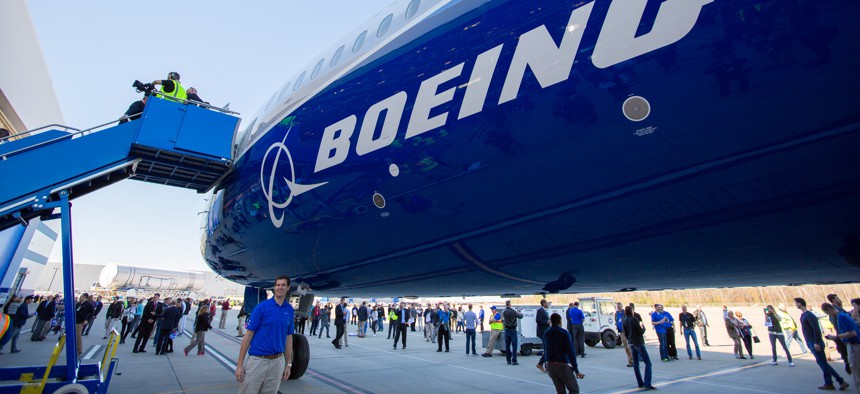
City of North Charleston via Flickr
Boeing Protests Air Force’s Jamming-Plane Decision, Alleging Conflict of Interest
Company officials say the decision to let L3 pick the aircraft means a choice has already been made.
Boeing is formally challenging a U.S. Air Force decision that allows L3 Technologies to choose a new plane to replace the EC-130 Compass Call intelligence aircraft.
The firm’s protest is a public rebuke of the Air Force, a measure rarely taken by America’s largest aerospace manufacturer.
“The Air Force’s approach is inconsistent with Congress’s direction in the 2017 NDAA and seems to ignore inherent and obvious conflicts of interest,” Caroline Hutchinson, a Boeing spokeswoman, said in an email Wednesday. “We believe that the U.S. Air Force and taxpayer would be best served by a fair and open competition, and that the Air Force can still meet its stated timeline of replacing the aging fleet of EC-130Hs within 10 years."
Boeing filed the protest with the Government Accountability Office on May 19. The nonpartisan office is expected to make a ruling by Aug. 28.
Company sources said the conflict of interest stems from L3’s unique relationship with airplane manufacturer Gulfstream, maker of the G550 business jet. L3 modifies G550s for foreign air forces. U.S. Air Force officials had wanted to buy the G550 in an earlier attempt to replace the Compass Call, and Boeing alleges that in choosing L3, the Air Force is implicitly picking the G550 again. Boeing would much rather the Air Force to hold a competition in which the Chicago-based company could pitch one of its jetliner-based aircraft to hold the sophisticated Compass Call electronics.
It’s rare for Boeing to contest a government contract. Most notably, it challenged the Air Force’s 2008 selection of Northrop Grumman and Airbus to build a new fleet of aerial refueling tankers. GAO upheld the protest, leading the Air Force to open a new competition. Three years later, Boeing won. (The tanker, called the KC-46 Pegasus, is a year behind schedule and Boeing has had to eat billions of dollars to fix programs that have cropped up in the plane’s development.)
So why protest now? Because the stakes are higher. The Compass Call program is the first of an expected string of programs to replace various fleets of decades-old Air Force intelligence planes based on the 707 jetliner. Winning the EC-130 replacement job would allow Boeing to argue the merits of commonality in future contests.
An L3 spokeswoman declined to comment, citing a company policy not to discuss projects under protest. On a recent earnings call, L3 executives said they had not chosen an aircraft and would solicit information for manufacturers.
The Air Force acknowledged Wednesday that it had received the protest.
“The Air Force remains committed to its acquisition approach,” Capt. Emily Grabowski, a service spokeswoman, said in an email. “Until the GAO has addressed Boeing's protest, the Air Force will not provide any further comment on the Compass Call acquisition.”
The decision had also been protested by Bombardier, whose protest was dismissed because the Air Force had yet to formally put L3 in charge.
Stéphane Villeneuve, vice president of Bombardier Specialized Aircraft, said the firm was aware of Boeing's protest, but would say whether the firm would protest itself.
"We are still evaluating our options in regards to the most appropriate way to preserve our rights to a fair and equitable aircraft selection process for the Compass Call program," he said in a statement provided by a spokeswoman.
Earlier this year, the Air Force gave L3 the responsibility for selecting a new plane for the Compass Call mission, saying that the service’s own acquisition officials lacked the expertise to make the decision. L3 is the company that installs the sophisticated intelligence equipment on the current Compass Call aircraft, 42-year-old C-130s. The Air Force says it urgently needs to replace the EC-130H with and aircraft that can fly further and higher and offer better reliability.
Boeing argues that it, too, has the expertise to be put in charge of the project.
NEXT STORY: 11 Major Agency Reforms in Trump’s Budget







